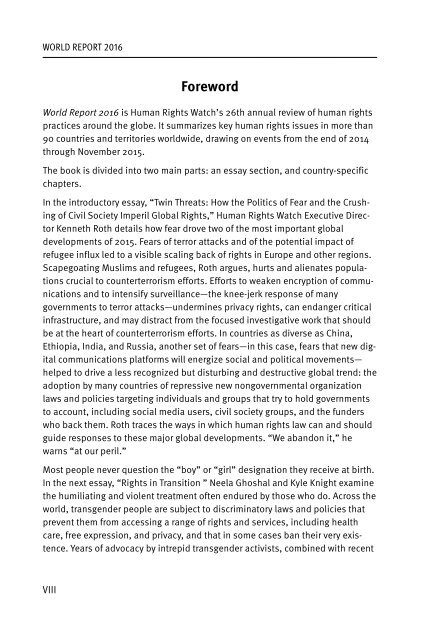Create successful ePaper yourself
Turn your PDF publications into a flip-book with our unique Google optimized e-Paper software.
WORLD REPORT 2016<br />
HUMAN RIGHTS WATCH<br />
Foreword<br />
World Report 2016 is Human Rights Watch’s 26th annual review of human rights<br />
practices around the globe. It summarizes key human rights issues in more than<br />
90 countries and territories worldwide, drawing on events from the end of 2014<br />
through November 2015.<br />
The book is divided into two main parts: an essay section, and country-specific<br />
chapters.<br />
In the introductory essay, “Twin Threats: How the Politics of Fear and the Crushing<br />
of Civil Society Imperil Global Rights,” Human Rights Watch Executive Director<br />
Kenneth Roth details how fear drove two of the most important global<br />
developments of 2015. Fears of terror attacks and of the potential impact of<br />
refugee influx led to a visible scaling back of rights in Europe and other regions.<br />
Scapegoating Muslims and refugees, Roth argues, hurts and alienates populations<br />
crucial to counterterrorism efforts. Efforts to weaken encryption of communications<br />
and to intensify surveillance—the knee-jerk response of many<br />
governments to terror attacks—undermines privacy rights, can endanger critical<br />
infrastructure, and may distract from the focused investigative work that should<br />
be at the heart of counterterrorism efforts. In countries as diverse as China,<br />
Ethiopia, India, and Russia, another set of fears—in this case, fears that new digital<br />
communications platforms will energize social and political movements—<br />
helped to drive a less recognized but disturbing and destructive global trend: the<br />
adoption by many countries of repressive new nongovernmental organization<br />
laws and policies targeting individuals and groups that try to hold governments<br />
to account, including social media users, civil society groups, and the funders<br />
who back them. Roth traces the ways in which human rights law can and should<br />
guide responses to these major global developments. “We abandon it,” he<br />
warns “at our peril.”<br />
Most people never question the “boy” or “girl” designation they receive at birth.<br />
In the next essay, “Rights in Transition ” Neela Ghoshal and Kyle Knight examine<br />
the humiliating and violent treatment often endured by those who do. Across the<br />
world, transgender people are subject to discriminatory laws and policies that<br />
prevent them from accessing a range of rights and services, including health<br />
care, free expression, and privacy, and that in some cases ban their very existence.<br />
Years of advocacy by intrepid transgender activists, combined with recent<br />
international pressure—including from the United Nations and Council of Europe—has<br />
increased access to legal recognition for transgender people and<br />
eased the process by which they can achieve it. No new or special rights lie at<br />
the heart of such crucial efforts, argue Ghoshal and Knight, but rather a fundamental<br />
“commitment to the core idea that the state or other actors will not decide<br />
for people who they are.”<br />
Around the world, girls are forced into child marriages that are often ruinous for<br />
their personal growth and disastrous for their ability to realize basic human<br />
rights. Child marriage often means leaving school, domestic violence, a cycle of<br />
poverty, and an increased risk of serious health problems and death due to early<br />
childbearing. One in nine girls in the developing world marry before 15, and one<br />
in three by 18. The UN Sustainable Development Goals adopted in September<br />
2015 aim to eliminate child marriage within 15 years, and many governments,<br />
donors, and civil society groups have rallied to the cause. But success, warns<br />
Nisha Varia, will not come easy and requires sustained political commitment to<br />
address social and cultural norms around girls' sexuality; coordination across<br />
multiple sectors; learning about what works and for whom; and empowering<br />
girls themselves with information and access to services so that they can realize<br />
a potential that so many of their mothers—themselves child brides—have been<br />
denied.<br />
Finally, in “Children Behind Bars,” Michael Bochenek looks at the global overuse<br />
of child detention. The UN Children’s Fund, UNICEF, estimates that more than<br />
one million children are behind bars worldwide. Some of these children are serving<br />
excessively long sentences, others are held for skipping school, running<br />
away from home, and other acts that should not be crimes, and some have never<br />
been tried for their alleged crimes. Migrant children are often held in immigration<br />
detention. Children with disabilities may be institutionalized. All of these<br />
practices violate international standards. A UN study soon underway will hopefully<br />
result in increased attention to these abusive practices and greater compliance<br />
with international standards. But as Bochenek notes, governments do not<br />
need to wait for this study; they can and should act now to develop alternatives<br />
to detention and ensure that children who are locked up receive schooling,<br />
health services, and humane treatment.<br />
The rest of the volume consists of individual country entries, each of which identifies<br />
significant human rights issues, examines the freedom of local human<br />
VIII<br />
IX


